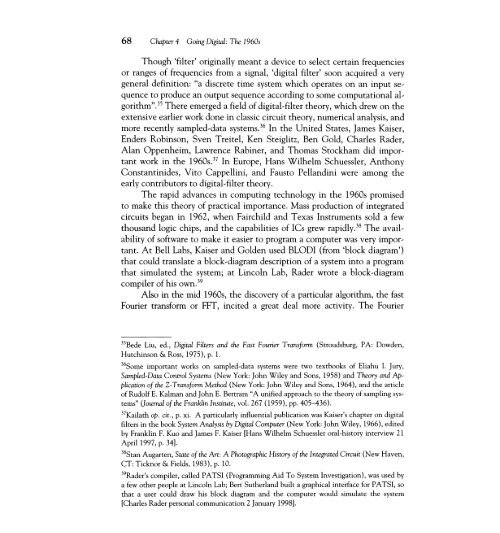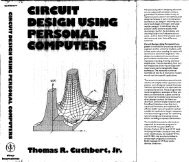Going Digital: The 1960s - IEEE Global History Network
Going Digital: The 1960s - IEEE Global History Network
Going Digital: The 1960s - IEEE Global History Network
Create successful ePaper yourself
Turn your PDF publications into a flip-book with our unique Google optimized e-Paper software.
68 Chapter 4 <strong>Going</strong> <strong>Digital</strong>: <strong>The</strong> <strong>1960s</strong><br />
Though 'filter' originally meant a device to select certain frequencies<br />
or ranges of frequencies from a signal, 'digital filter' soon acquired a very<br />
general definition: "a discrete time system which operates on an input se ...<br />
quence to produce an output sequence according to some computational al...<br />
gorithm".35 <strong>The</strong>re emerged a field of digital...filter theory, which drew on the<br />
extensive earlier work done in classic circuit theory, numerical analysis, and<br />
more recently sampled...data systems. 36 In the United States, James Kaiser,<br />
Enders Robinson, Sven Treitel, Ken Steiglitz, Ben Gold, Charles Rader,<br />
Alan Oppenheim, Lawrence Rabiner, and Thomas Stockham did impor...<br />
tant work in the <strong>1960s</strong>. 37 In Europe, Hans Wilhelm Schuessler, Anthony<br />
Constantinides, Vito Cappellini, and Fausto Pellandini were among the<br />
early contributors to digital...filter theory.<br />
<strong>The</strong> rapid advances in computing technology in the <strong>1960s</strong> promised<br />
to make this theory of practical importance. Mass production of integrated<br />
circuits began in 1962, when Fairchild and Texas Instruments sold a few<br />
thousand logic chips, and the capabilities of ICs grew rapidly.38 <strong>The</strong> avail...<br />
ability of software to make it easier to program a computer was very impor...<br />
tant. At Bell Labs, Kaiser and Golden used BLODI (from 'block diagram')<br />
that could translate a block...diagram description of a system into a program<br />
that simulated the system; at Lincoln Lab, Rader wrote a block...diagram<br />
compiler of his own. 39<br />
Also in the mid <strong>1960s</strong>, the discovery of a particular algorithm, the fast<br />
Fourier transform or FFT, incited a great deal more activity. <strong>The</strong> Fourier<br />
35Bede Liu, ed., <strong>Digital</strong> Filters and the Fast Fourier Transform (Stroudsburg, PA: Dowden,<br />
Hutchinson & Ross, 1975), p. 1.<br />
36Some important works on sampled..data systems were two textbooks of Eliahu I. Jury,<br />
Sampled..Data Control Systems (New York: John Wiley and Sons, 1958) and <strong>The</strong>ory and Ap..<br />
plication of the Z..Transform Method (New York: John Wiley and Sons, 1964), and the article<br />
of Rudolf E. Kalman and John E. Bertram "A unified approach to the theory of sampling sys..<br />
tems" (Journal of the Franklin Institute, vol. 267 (1959), pp. 405-436).<br />
37Kailath op. cit., p. xi. A particularly influential publication was Kaiser's chapter on digital<br />
filters in the book System Analysis by <strong>Digital</strong> Computer (New York: John Wiley, 1966), edited<br />
by Franklin F. Kuo and James F. Kaiser [Hans Wilhelm Schuessler oral..history interview 21<br />
April 1997, p. 34].<br />
38Stan Augarten, State of the Art: A Photographic <strong>History</strong> of the Integrated Circuit (New Haven,<br />
CT: Ticknor & Fields, 1983), p. 10.<br />
39Rader's compiler, called PATSI (Programming Aid To System Investigation), was used by<br />
a few other people at Lincoln Lab; Bert Sutherland built a graphical interface for PATSI, so<br />
that a user could draw his block diagram and the computer would simulate the system<br />
[Charles Rader personal communication 2 January 1998].
















